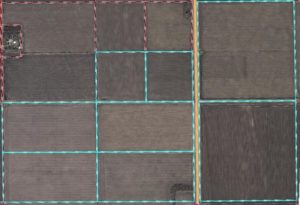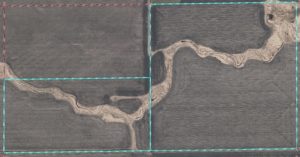There is a common saying in selling real estate (well, selling anything really) that goes something like this:
“Something is only worth what someone else is willing to pay for it at the time you wish to sell it.”
There is a lot of truth to that, but of course MANY factors will ultimately drive what that price will be that someone else is willing to pay. In this multi-part blog series, we’ll cover some of the largest drivers of ag land values. We’ll also provide some context to our local Southern Red River Valley land market and how it relates to these factors. Let’s continue!
Read Part 1: Soils
Read Part 2: Drainage
Part 3: Size & Shape
 It is easy for people to understand that the LARGER a piece of farm land, the more money the seller will get as a whole. However, not everyone understands the inverse relationship that often exists with the size of the parcel compared to the dollars per acre received. In other words, the seller of a half section (320 acres) may not receive as much money PER ACRE as the seller of a 40 acre parcel would receive PER ACRE. The reason? The buyer pool for smaller farm land parcels is LARGER than the pool of buyers who can afford to buy or finance large parcels. Remember that ancient economics class you once took?! Well, higher competition (demand) usually equals a higher price per acre as a result.
It is easy for people to understand that the LARGER a piece of farm land, the more money the seller will get as a whole. However, not everyone understands the inverse relationship that often exists with the size of the parcel compared to the dollars per acre received. In other words, the seller of a half section (320 acres) may not receive as much money PER ACRE as the seller of a 40 acre parcel would receive PER ACRE. The reason? The buyer pool for smaller farm land parcels is LARGER than the pool of buyers who can afford to buy or finance large parcels. Remember that ancient economics class you once took?! Well, higher competition (demand) usually equals a higher price per acre as a result.
This doesn’t mean an owner of multiple sections of land should split them all up into 40 acre tracts to achieve top dollar. It does however mean that sellers should consider having some flexibility in how land is divided or sold when multiple tracts or larger tracts are going to be offered for sale. If you have heard about “Multipar” or “Multi parcel” land sales lately, that’s because they are a growing trend to help offer Buyers a wider variety of options to buy land which in the end usually results in more money for the Seller. Every situation is different and should be evaluated on its own merits, so please do not hesitate to contact us if you would like some assistance in evaluating your options (even if your land isn’t in the Red River Valley we can still offer you some free advice!).
 One other aspect related to “size” and how it can impact value is the shape of the parcel and the amount of tillable acres on it (how many acres can you plant and harvest crops in other words). In the Red River Valley of North Dakota and Minnesota, most parcels are “square, flat and black.” However, because of things like drainage (natural or man-made), wetlands, railroad tracks, creek beds, telephone poles, coulees, etc., some tracts have an inefficient shape and/or a much lower percentage of tillable acres than those without these issues (which are often referred to as “encumbrances”). Some ag land tracts can be less efficient or hard for farmers with their larger equipment. For example, irregular shaped parcels can lead to over/under application of seed/fertilizer/chemicals, more time to plant/till/harvest, etc. which have a dragging effect on income or yield potential. Sellers must remember that buyers will place their value (and offers) on the tillable acres because that is where they will get their income (either by farming those acres or renting them out), so this must be taken into account when thinking about the value of your land. If you aren’t sure how many tillable acres your parcel has or the shape of it, you can always call your local county’s FSA office and ask them for more details (read Part 2 for help on contacting your local FSA office). We can also help look much of this up as well if you want to contact us.
One other aspect related to “size” and how it can impact value is the shape of the parcel and the amount of tillable acres on it (how many acres can you plant and harvest crops in other words). In the Red River Valley of North Dakota and Minnesota, most parcels are “square, flat and black.” However, because of things like drainage (natural or man-made), wetlands, railroad tracks, creek beds, telephone poles, coulees, etc., some tracts have an inefficient shape and/or a much lower percentage of tillable acres than those without these issues (which are often referred to as “encumbrances”). Some ag land tracts can be less efficient or hard for farmers with their larger equipment. For example, irregular shaped parcels can lead to over/under application of seed/fertilizer/chemicals, more time to plant/till/harvest, etc. which have a dragging effect on income or yield potential. Sellers must remember that buyers will place their value (and offers) on the tillable acres because that is where they will get their income (either by farming those acres or renting them out), so this must be taken into account when thinking about the value of your land. If you aren’t sure how many tillable acres your parcel has or the shape of it, you can always call your local county’s FSA office and ask them for more details (read Part 2 for help on contacting your local FSA office). We can also help look much of this up as well if you want to contact us.
Remember, the size and shape of your land is just one of many factors that impact the value of farm land. Stay tuned for future articles in this blog series that will uncover more.
Until next time!
Andy

